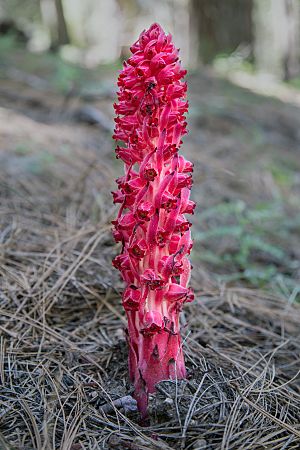Snow plant facts for kids
Quick facts for kids Snow plant |
|
|---|---|
 |
|
| Scientific classification | |
| Genus: |
Sarcodes
|
| Species: |
sanguinea
|
The Snow Plant, also known by its scientific name Sarcodes sanguinea, is a very unique and bright red flowering plant. It grows in the mountains of western North America and is part of the heath family (Ericaceae). It often appears in early spring or summer, sometimes even pushing up through melting snow, which is how it got its common name!
Contents
The Bright Red Snow Plant
The Snow Plant is the only species in its group, called a monotypic genus. This means it's the only type of Sarcodes plant known.
How the Snow Plant Gets Its Food
Unlike most plants, the Snow Plant is bright red and doesn't have any green parts. This means it can't make its own food using sunlight, a process called photosynthesis. So, how does it survive?
The Snow Plant is a parasitic plant. It gets all its food and nutrients from tiny underground fungi. These fungi are called mycorrhizal fungi. They usually have a special partnership with tree roots. In this partnership, the trees give the fungi sugars, and the fungi help the trees get water and nutrients from the soil.
The Snow Plant cleverly taps into this underground network. It connects to the fungi and "steals" the sugars that the trees have made. This way of getting food is called mycoheterotrophy. The Snow Plant is very picky about its food source. It can only connect with a specific type of fungus called Rhizopogon ellenae.
What the Snow Plant Looks Like
The part of the Snow Plant that you see above the ground is its flower stalk. It's a tall, bright scarlet red stem covered in many flowers. These flowers are arranged in a cluster, like a long spike. The stem also has many strap-like, pointed leaves called bracts. These bracts are also bright red or orange and have fringed edges.
Where the Snow Plant Lives
The Snow Plant grows naturally in the mountain areas of the California Floristic Province. You can find it from the Oregon Cascade Range in the north, all through the mountains of California. It also grows in the Sierra de San Pedro Mártir range in northern Baja California, Mexico. It doesn't grow in the California Coast Ranges between the Klamath Mountains.
The scientific name sanguinea means "blood-red," which perfectly describes its striking color. It often appears when snow is still on the ground. In very high mountains, like the High Sierra Nevada and Cascades, it might not appear until July!
Gallery
Images for kids
-
Stand of Sarcodes near Donner Lake
See also
 In Spanish: Sarcodes sanguinea para niños
In Spanish: Sarcodes sanguinea para niños




